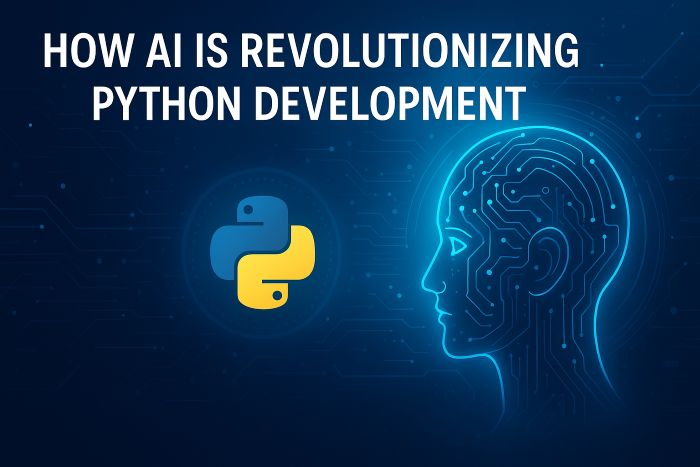I remember when writing Python meant having the documentation open in one tab and Stack Overflow in another. We spent hours debugging obscure syntax errors or trying to optimize a loop that was slowing down the entire application. That era is fading fast. We are currently witnessing a fundamental shift in how we write software—a shift that represents the true future of code. Artificial intelligence has moved from being the product we build to the partner we build with. In my years of working with technology, I have never seen a transformation quite as rapid or as impactful as the integration of AI into the Python development workflow. It is changing everything from how we prototype to how we maintain legacy codebases.
Table of contents
The New Era of Intelligent Programming
The days of manually typing out every single character of boilerplate code are behind us. Intelligent programming does not mean the machine takes over entirely. It means the machine handles the tedious parts so we can focus on the logic and the architecture. I view this not as a replacement of human ingenuity but as a massive multiplier of it. We are moving from being code writers to code architects. The barrier to entry is lowering, but the ceiling for what a single developer can achieve is shooting into the stratosphere with the future of code.
This shift brings a unique challenge for businesses and technical leaders. You need a team that understands not just the syntax of Python but also how to wield these new AI-powered tools to deliver value faster. As companies rush to integrate these technologies, the demand for skilled talent is skyrocketing. If you are looking to scale your team to meet this new standard, you might need to hire Python developers who understand how to leverage these AI tools effectively. Finding the right people is crucial because the tool is only as good as the hands that wield it.
Generative AI and Code Completion Tools
The most visible impact of AI on our daily work is in code completion. We are not talking about the simple auto-complete features of the past that just suggested variable names. I am talking about Large Language Models (LLMs) that understand context. When I use tools like GitHub Copilot or Amazon Q, it feels less like using a tool and more like pair programming with an incredibly fast junior developer who has memorized the entire internet.
These tools analyze the context of the file I am working on and often the entire repository. They suggest full functions, write documentation strings, and even propose unit tests before I have even finished typing the function definition. For example, if I start writing a Python function to process a CSV file and clean the data using Pandas, the AI often anticipates the standard library imports and the likely data cleaning steps I will need.

However, it is vital to understand that these models work on probability. They predict the next token based on patterns they have seen in billions of lines of open-source code. This means they are incredibly good at standard patterns but can sometimes struggle with novel or highly specific business logic. I always treat their output as a draft. It is a very good draft, but it requires my review.
Automated Debugging and Refactoring
Debugging is arguably the most painful part of development. I have spent days chasing bugs that turned out to be simple logical errors. AI is changing this dynamic completely. In the future of code, Modern IDEs integrated with AI can analyze a stack trace and explain exactly what went wrong in plain English. They do not just point to the line of error. They suggest the fix.
Beyond simple bug fixes, AI is proving to be a powerhouse for refactoring. We all have that one legacy module in our codebase that everyone is afraid to touch. It works, but it is a tangled mess of spaghetti code. I have used AI tools to break down massive functions into smaller, more readable components. You can highlight a block of code and ask the AI to rewrite it to be more efficient or to follow PEP 8 standards more strictly.
This capability extends to security as well. AI scanners can look at your Python code and identify potential vulnerabilities like SQL injection risks or hard-coded API keys. It acts as a proactive security guard that alerts you to issues before you even commit your code to the repository.
Python as the Engine of AI
It is impossible to talk about this topic without acknowledging the symbiotic relationship between Python and AI. Python is not just a beneficiary of AI tools. It is the language that makes them possible. The reason we have this revolution is largely due to the Python ecosystem. Libraries like PyTorch, TensorFlow, and JAX have made Python the lingua franca of machine learning.
When I build AI applications, I am relying on Python’s simplicity to glue together complex mathematical operations. The ecosystem is vast. We have Scikit-learn for traditional machine learning, Pandas for data manipulation, and NumPy for numerical computation. This dominance means that AI coding assistants are particularly good at writing Python because there is so much high-quality training data available.
If you are building a Retrieval-Augmented Generation (RAG) system or fine-tuning a model, you are likely doing it in Python. This creates a virtuous cycle. As we use Python to build better AI models, those models become better at writing Python code, which helps us build even better models.
Navigating Risks and Best Practices
Despite my enthusiasm, I remain cautious. There are real risks involved in handing over the reins to an algorithm. The most prominent issue is “hallucination.” AI can sound incredibly confident while being completely wrong. I have seen it invent Python libraries that do not exist or suggest syntax that was deprecated five years ago.
There are also legal and ethical concerns regarding copyright. These models were trained on public code, and there is an ongoing debate about the ownership of AI-generated code. For enterprise applications, data privacy is another massive concern. You have to be careful about pasting proprietary code into a public chatbot window.
To mitigate these risks, I recommend a “human-in-the-loop” approach. Never let AI push code directly to production. The future of code reviews becomes even more important when the code is generated by a machine. You need to verify that the logic is sound and that it does not introduce security flaws.
Comparison of Top AI Coding Assistants for Python
To help you understand the landscape, I have compiled a comparison of the current top tools we see in the market.
| Tool | Primary Strength | Integration | Best For |
| GitHub Copilot | Context awareness and vast training data | VS Code, JetBrains, Visual Studio | General purpose Python development and fast prototyping |
| Tabnine | Privacy and local model options | Most major IDEs | Enterprise teams with strict data privacy requirements |
| Amazon Q | AWS ecosystem integration | AWS Cloud9, VS Code, JetBrains | Developers heavily working with AWS services |
| Gemini Code Assist | Large context window and reasoning | Google Cloud, VS Code | Complex codebases requiring deep context analysis |
| Cursor | Native AI-first editor experience | Standalone Editor (VS Code fork) | Developers willing to switch editors for deeper AI integration |
Key Benefits of AI-Augmented Development with the Future of Code
The transition to AI-assisted development offers tangible benefits that I have observed firsthand in my projects.
- Accelerated Prototyping: You can go from a vague idea to a working proof-of-concept in a fraction of the time. The AI handles the scaffolding while you focus on the core feature set.
- Reduced Cognitive Load: Instead of remembering the exact syntax for every Pandas function, you can describe what you want to do in natural language. This frees up your brain to think about the bigger picture.
- Continuous Learning: I often learn new libraries or better ways to write list comprehensions simply by seeing what the AI suggests. It acts as an always-on tutor.
- Improved Test Coverage: AI excels at writing boilerplate test cases. It can generate unit tests for edge cases you might not have thought of, leading to more robust applications.
- Standardization: For teams, AI tools can be tuned to enforce specific coding styles and standards, ensuring that the codebase looks uniform regardless of who wrote the specific module.
Conclusion
We are standing at the precipice of a new age in software engineering. AI in Python development is not a fad that will fade away. It is a fundamental restructuring of how we interact with computers to solve problems. The tools available today are already impressive, but they are just the beginning. As these models get smarter and more context-aware with future of code, the friction between thought and code will continue to decrease.
However, the human element remains irreplaceable. The creativity to solve novel problems, the empathy to understand user needs, and the wisdom to make architectural decisions are things that AI cannot replicate. The most successful developers of the future will not be those who resist AI, nor those who blindly follow it. They will be the ones who learn to dance with it.
I encourage you to pick one of the tools mentioned above and incorporate it into your workflow this week. Do not just use it to write code. Use it to explain code, to write tests, and to challenge your assumptions. The future of Python is bright, and it is intelligent.











